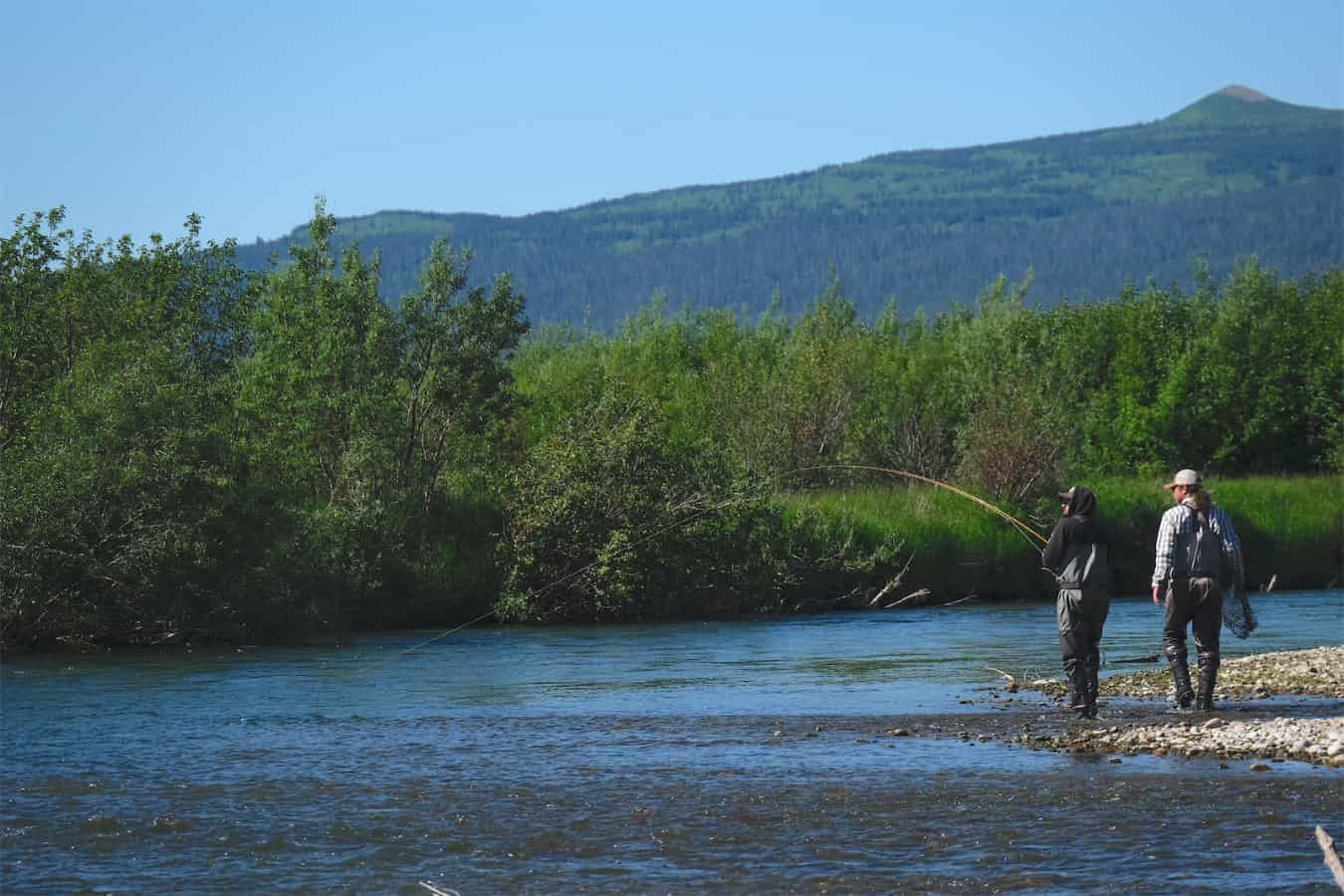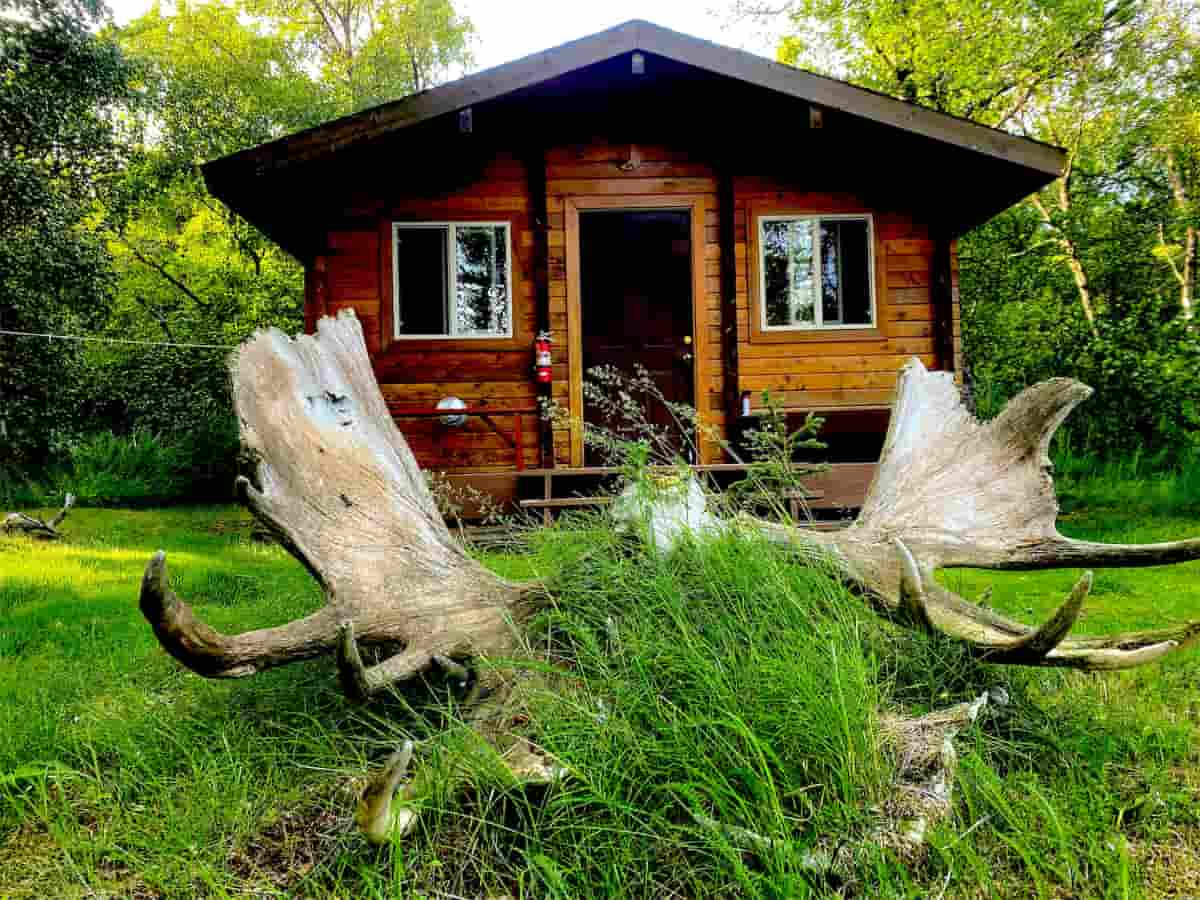Never too Early: Plan Now for Hot Summer Fishing in Alaska

With the first winter storms barrelling across the country, it may seem early to consider your next trip to The Great Land. However, to secure a spot during Alaska’s 2024 season, especially if you want to chase those big rainbows on surface patterns, now is the time to plan.
There’s good reason to do so. During Bristol Bay’s early season, meaning June through mid-July, you can target rainbows on general attractor patterns and mice imitations, fish that stretch to 30 inches long. At the same time, those rainbows—plus Dolly Varden and lake trout—crush floating smolt imitations at river outlets and in the region’s various lakes. At no other time are these fish as willing to eat up top.
I wanted in on that action, so two seasons ago I grabbed a flight from Missoula to Anchorage and another from Anchorage to Kulik Lodge via Katmai Air. From there I wiggled into a floatplane and cruised another 20 minutes to Grosvenor Lodge, which is located on a small spit of land partially separating Grosvenor and Coville lakes. The structures, including three guest cabins, a main lodge, and a cookhouse, are situated in lush, tall grass with a surrounding abundance of willows, birch, and moss-covered moose skulls. Quaint. Unique. Beautiful.
It’s the only lodge in this particular area and offers the best access to American Creek and other tributary streams, despite being located deep in Katmai National Park. When other area lodges are grounded by weather, Grosvenor guests simply climb into a jetboat and take a 20-minute jog to the American Creek outlet.
From mid-July through August, fishing American Creek is all about drifting beads behind spawning salmon. While that’s a productive method and puts plenty of trout in the net, guides and anglers sometimes tire from the routine, maybe thinking: Isn’t there something else? The answer is yes, if you hit Grosvenor before the sockeye salmon arrive. As mentioned, those rainbows key in on some big, meaty insects, including stoneflies, caddis, and drakes.. When that occurs, a day on American Creek might feel like a Rocky Mountains trout trip–except you’re way more remote, the fish average 19 to 25 inches long, and they are line-burners of a unique brand. Don’t bring the dainty 3- and 4-weights here—you’d be lucky to hold a 20-incher on American Creek with a 5-weight.
I didn’t really consider the dry-fly option when I headed to Grosvenor, but I did pack a mix of dries that proved very beneficial when we saw a head pop up along a deep bank. Todd Emerson, who started guiding the Katmai area in 2004 and serves as Grosvenor’s manager, said, “I’ve seen that fish before and we haven’t hooked him yet.”
Well, then we might just have to hook it, right?

I spent a half hour or more trying to lodge a cast between a log that was about four feet off the bank and a stack of willows a few yards upstream, all waving in an unruly 20-mile-an-hour wind. Let the line go at the wrong time and it would end up in the willows. Make a bad cast and you’d paint the log with flies. Which is just what I did. In the end, we moved in on that big, picky fish, Emerson holding the boat just above the log while I dabbed a Caddis Variant (the closest match I had for some grayish colored drakes) over the log and along the bank. Got the fish to eat. Held a brief moment of hope when it took off downstream, only to realize I was cooked when it swapped ends and ran back to its lair, wrapping my leader on the log in the process. Ping! Probably would have gone 28 inches.
We spent the rest of the day catching some nice Dolly Varden, chasing more rainbows with the dry, and talking about what makes Grosvenor and American Creek such an absolutely unique fishery in a Bristol Bay region teaming with options.
“Katmai is an amazing area, and I’ve fished the majority of streams that you can feasibly get into from a small lake and a float plane,” Emerson told me. “American Creek is my favorite trout stream on the planet. It reminds me of Michigan—the trees, the sweepers, all the snags on the lower end of the creek. The upper creek is totally different. All low tundra, no trees, boulder picking, beautiful rocks, just a whole different system. But dry-fly fishing is spectacular up there as well. The whole thing is 49 miles from top to bottom.”
Emerson thinks the fish behave differently in this valley than elsewhere in the region.
“These trout here act like trout,” Emerson added. “Some of those larger systems, and even on the Moraine, those trout act like steelhead, which at times is a fun game to play. But these trout orient to structure and key in on bugs. In the early season you can get them on dries, you can get them with the mouse, get tricky with the leech. It’s an intimate stream where you can take a section and just dissect it. It’s a stunning place to be and the trout are gorgeous.”
Those fish are particularly beautiful right now, mostly because they are big, maybe even at the top end of a boom cycle after several years of massive sockeye salmon returns and an overabundance of forage. Each of these fish seems to be trophy-sized, camera-ready, and a big-time test on a smallish river with roots and deadfall around every bend.
“The number of quality size fish—meaning 25 to 30 inches long—is astounding right now,” Emerson said. “The chance to catch a fish of that magnitude on a dry fly is mind-blowing.
“Kvichak, Naknek,” Emerson said. “Yeah, you can swing the spey rod and get them on a leech, which I love. But to have these big heads coming up and sipping dry flies like we have right now, you aren’t going to see that on those other rivers. There’s tons of water to probe in the [lower] sections where I can fish with the jetboat. But there is also the option of hiking into what we call ‘the braids,’ where I park the boat, we throw on the backpacks, and go sight-fishing, just cruising through all these channels and braids. You are looking at mid- to upper-20-inch fish where you have to figure out, first off, how am I going to make the cast without getting caught in the tree. OK, let’s say you make the cast. How are you going to get the drift? Then, let’s say he eats it. Set the hook and where is he going? When it all actually happens and [the angler] puts the wood to it, and the fish turns away from the logjam, and we run 50 yards downstream, and finally get ahold of it–it’s pretty cool.”
As mentioned, American Creek isn’t just about rainbows. Dolly Varden and Arctic char are available all summer and fall and they reach 30 inches long. Early in the year they are silver and sleek, moving out of the lake to eat fry and anything else those aggressive dudes can find. As the salmon move in, the Dollies stack up behind them, chowing down on eggs. They put on weight quickly and start taking on their spectacular spawning dress.
“They are stunning,” Emerson said. “White-tipped fins and just colored up beyond belief. The males get kyped-out and they are just really cool looking fish. Most people who come to Katmai just want to catch the biggest rainbow they can catch. I get it. But when you’re holding onto a 27-inch Dolly Varden that is colored up, and it’s eight pounds in your hands . . .” Enough said.

One reason you might fish Grosvenor versus another lodge is because it is the only stick-built structure on the planet offering access to lower American Creek without the use of an aircraft. It gives Emerson an advantage over other lodges, guides, and guests who might be tapping their fingers on a table—instead of fishing—when weather comes in.
“There are situations where King Salmon and Igiugig get fogged in and I can slip in here and we can have access to American for ourselves with bright blue skies overhead,” Emerson said.
As for the actual lodge and location, Emerson feels like it’s unrivaled.
“We are a concession within Katmai National Park and we are responsible for preserving the place [including the structures] as it’s always been,” he said. “So, when you get off the plane, it’s like stepping back in time. There’s no air traffic. There are no people. The location is so tucked away it makes you feel like you are in the middle of nowhere. We are off the beaten path, literally, but it’s just a quick boat ride to American Creek.
“The other direction, across Grosvenor Lake, we can go to tributaries that fish well,” Emerson said. “We also have the Grosvenor River, which has some very sizable pike. And one special feature is the Hardscrabble. This is a stream that not many people get to see and we are the only people who can access it because we are the only people that have a jetboat to go up and fish it. That’s pretty special—exclusive access to locations other people don’t have.”
When fishing at Grosvenor, especially in the early season when it doesn’t really get dark in Alaska, you can fish after dinner or before breakfast, with the possibility of catching some lake trout and maybe even a rainbow.
At times, the lake trout chase and herd smolt, often cartwheeling out of the water to catch their prey. The gulls and mergansers see the fracas and charge over for scraps. It’s a spectacle. And, if the fish cruise close enough to shore, a smolt pattern is sure to get them.
“It’s such a cool phenomenon to witness,” Emerson said. “It’s a spectacular scene. The lake trout average about 22 to 24 inches, but we’ve landed a few 15-pounders on the fly. You can literally be a cast away from marauding fish while you’re standing there drinking coffee.”
Surely there are reasons to fish Alaska in late July and August—more bears, maybe even more fish in the rivers, all following sockeye salmon. There are those colored-up Dollies and possibly better weather. But, after fishing Grosvenor in late June and early July, I could argue there is no better time to hit Katmai. Emerson is right—seeing those big snouts breaking the surface on American Creek; watching lake trout cartwheeling for smolt; catching fresh dollies that are full of fight; all while staying at an intimate lodge on a forgotten patch of the world, is very, very cool.











